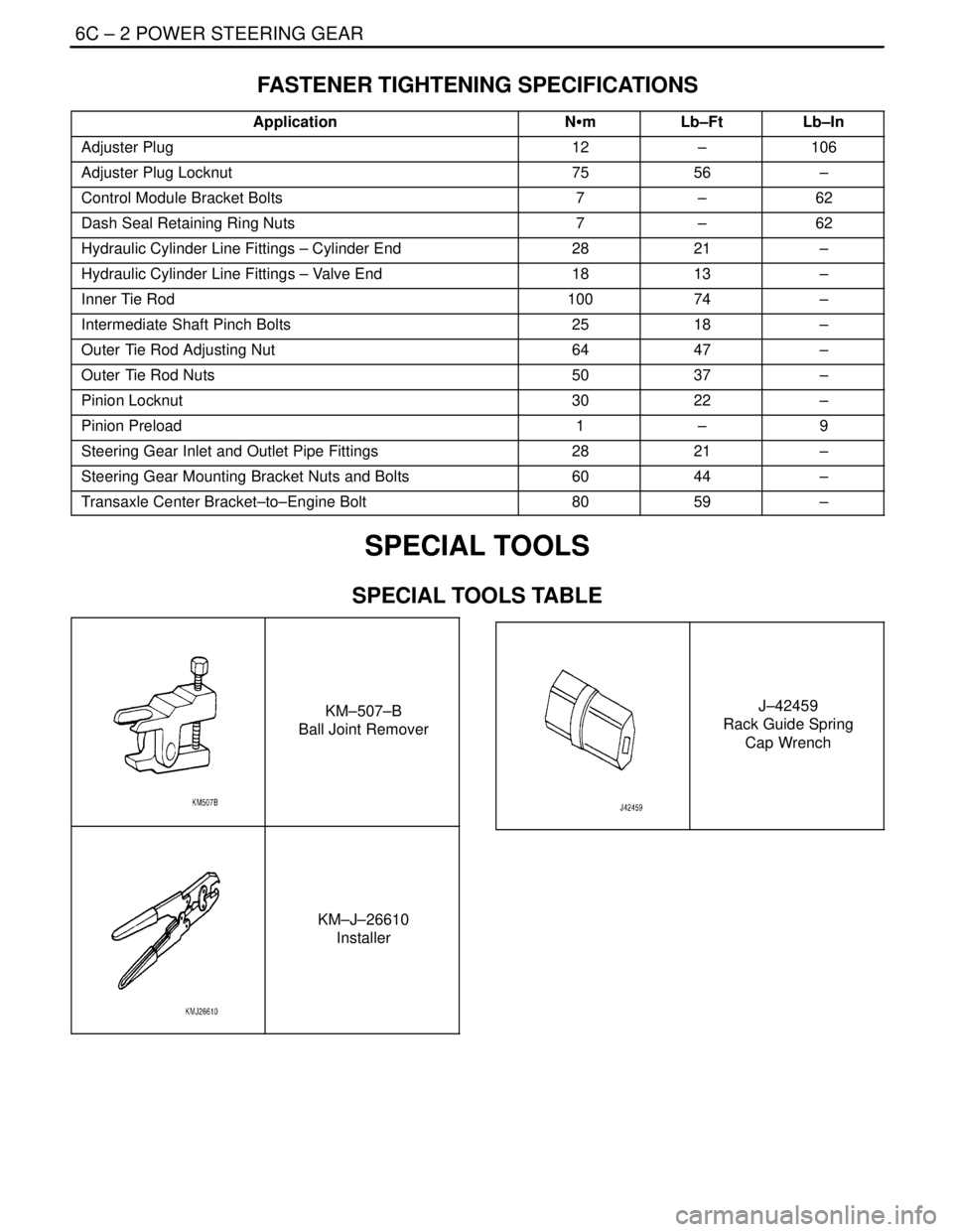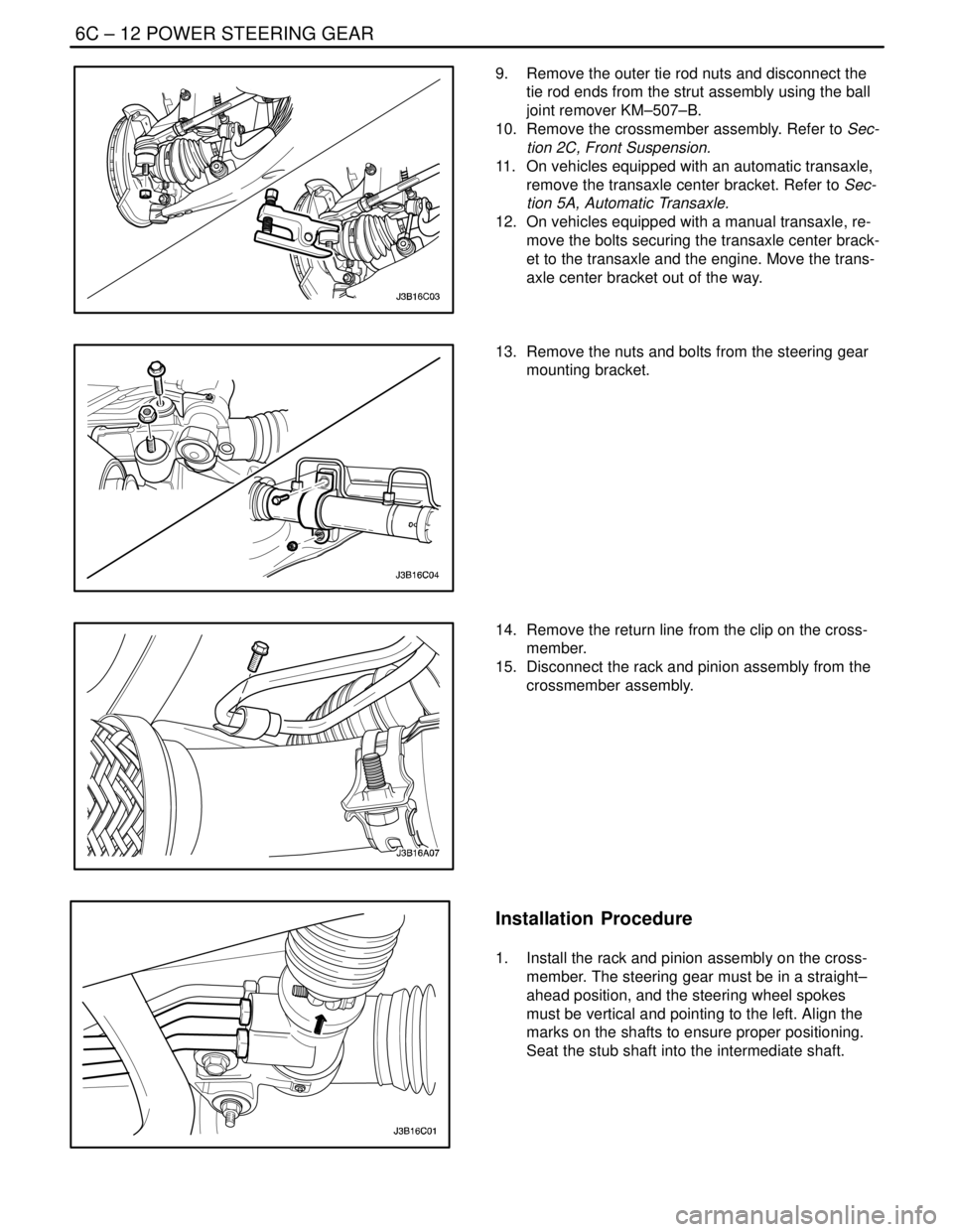2004 DAEWOO NUBIRA engine e
[x] Cancel search: engine ePage 1903 of 2643

6A – 2IPOWER STEERING SYSTEM
DAEWOO V–121 BL4
DIAGNOSIS
POWER STEERING SYSTEM
PRESSURE TEST
Tools Required
KM–354–B Pressure Test Gauge Kit
Check the fluid pressure as follows to determine whether
the trouble is in the pump or the gear unit.
Test Procedure
1. Check the power steering fluid level and the power
steering pump belt tension. Refer to ”Checking and
Adding Fluid” in this section and Section 6B, Power
Steering Pump.
2. Disconnect the high pressure line at the pump. Use
a small container to catch any fluid.
3. Connect the hose of the pressure test gauge kit
KM–354–B to the power steering pressure hose
from the power steering pump.
4. Place the gear selector lever in PARK (automatic
transaxle–equipped vehicles) or NEUTRAL (manual
transaxle–equipped vehicles). Set the parking
brake.
5. Open the gauge valve fully.
6. Start the engine and let it idle.
7. Turn the steering wheel from lock to lock several
times to warm the fluid to operating temperature.
8. Increase the engine speed to 1,500 rpm.
Notice : The power steering pump could be damaged if
the valve is fully closed for more than 5 seconds.
9. Close the gauge valve fully, and read the pressure.
The pump pressure with the valve closed should be
between 8,330 kPa to 8,820 kPa (1,208 psi to
1,279 psi). With electronic variable orifice, the pres-
sure should be between 8,500 kPa to 8,960 kPa
(1,233 psi to 1,299 psi).
10. Immediately open the gauge valve fully.
11. Turn the steering wheel all the way to the left and
the right. If the pressure is within the specified lim-
its, the problem is not in the pump. Check the pow-
er steering gear for leaks.
POWER STEERING SYSTEM LEAK
TEST
General Procedure
Inspect the following:
S The fluid reservoir for overfill.
S Fluid for aeration and overflow.
S The hoses for loose connections.
S The torsion bar, stub shaft and adjuster seals for
leaks.
S The component sealing surfaces for damage.
Important : Verify the exact point of the leak. The point
from which the fluid is dripping is not necessarily the point
at which the system is leaking. When service is required,
clean the leak area upon disassembly, replace the leaking
seal, check the component sealing surfaces for damage
and reset the torque bolt to specifications, where required.
External Leak Check
The purpose of this procedure is to pinpoint the location of
the leak. In some cases, the leak can be easily located, but
seepage–type leaks may be harder to find. To locate seep-
age leaks, use the following method:
1. With the engine off, wipe dry the complete power
steering system.
2. Check the power steering fluid level in the pump’s
reservoir. Adjust the fluid level as necessary. Refer
to ”Checking and Adding Fluid” in this section.
Notice : Do not hold the steering wheel at a stop for any
length of time as this can damage the power steering
pump.
3. Start the engine. Turn the steering wheel counter-
clockwise and clockwise from stop to stop several
times.
4. Find the exact area of the leak and repair it.
Page 1904 of 2643

POWER STEERING SYSTEM 6A – 3
DAEWOO V–121 BL4
MAINTENANCE AND REPAIR
ON–VEHICLE SERVICE
BLEEDING THE POWER STEERING
SYSTEM
If the power steering hydraulic system has been serviced,
an accurate fluid level reading cannot be obtained until the
air is bled from the system. Follow these steps to bleed the
air from the system.
1. Turn the wheels all the way to the left and add the
power steering fluid to the MIN mark on the fluid
level indicator.
Notice : When adding fluid or making a complete fluid
change, always use DEXRON®–II or III power steering
fluid. Failure to use the proper fluid will cause hose and
seal damage and fluid leaks.
2. Start the engine. With the engine running at fast
idle, recheck the fluid level. If necessary, add fluid
to bring the level up to the MIN mark.
3. Bleed the system by turning the wheels from side to
side without reaching the stop at either end. Keep
the fluid level at the MIN mark. The air must be
eliminated from the fluid before normal steering ac-
tion can be obtained.
4. Return the wheels to the center position. Continue
running the engine for 2 to 3 minutes.
5. Road test the car to be sure the steering functions
normally and is free from noise.
6. Recheck the fluid level as described in steps 1 and
2. Make sure the fluid level is at the MAX mark af-
ter the system has stabilized at its normal operating
temperature. Add fluid as needed.
CHECKING AND ADDING FLUID
Notice : When adding fluid or making a complete fluid
change, always use DEXRON®–II or III power steering
fluid. Failure to use the proper fluid will cause hose and
seal damage and fluid leaks.
1. The power steering fluid level is indicated either by
marks on a see–through fluid reservoir or by marks
on a fluid level indicator on the fluid reservoir cap.
2. If the fluid is warmed up to 66°C (150°F), the fluid
level should be between the MAX and MIN marks.
Add fluid as needed.
3. If the fluid is cool, 21°C (70°F), the fluid level
should be at the MIN mark. Add fluid as needed.
Page 1917 of 2643

6B – 8IPOWER STEERING PUMP
DAEWOO V–121 BL4
GENERAL DESCRIPTION
AND SYSTEM OPERATION
POWER STEERING PUMP
The power steering pump is a multivaned hydraulic pump.
The serpentine accessory drive belt on the engine drives
the power steering pump.The power steering pump provides the hydraulic pressure
to the power steering gear.
The power steering gear uses the hydraulic pressure to
assist in steering the vehicle.
The power steering system uses a remote reservoir in or-
der to make available more space in the engine compart-
ment.
Page 1919 of 2643

6C – 2IPOWER STEERING GEAR
DAEWOO V–121 BL4
FASTENER TIGHTENING SPECIFICATIONS
ApplicationNSmLb–FtLb–In
Adjuster Plug12–106
Adjuster Plug Locknut7556–
Control Module Bracket Bolts7–62
Dash Seal Retaining Ring Nuts7–62
Hydraulic Cylinder Line Fittings – Cylinder End2821–
Hydraulic Cylinder Line Fittings – Valve End1813–
Inner Tie Rod10074–
Intermediate Shaft Pinch Bolts2518–
Outer Tie Rod Adjusting Nut6447–
Outer Tie Rod Nuts5037–
Pinion Locknut3022–
Pinion Preload1–9
Steering Gear Inlet and Outlet Pipe Fittings2821–
Steering Gear Mounting Bracket Nuts and Bolts6044–
Transaxle Center Bracket–to–Engine Bolt8059–
SPECIAL TOOLS
SPECIAL TOOLS TABLE
KM–507–B
Ball Joint Remover
KM–J–26610
Installer
J–42459
Rack Guide Spring
Cap Wrench
Page 1921 of 2643

6C – 4IPOWER STEERING GEAR
DAEWOO V–121 BL4
Steering Surges or Jerks When Turning with Engine Running
ChecksAction
Check the power steering pump for insufficient pressure.Replace the power steering pump.
Check the power steering pump flow control valve for
sticking and improper operation.Replace the power steering pump.
Check the power steering pump serpentine belt for slip-
page.Tighten the power steering serpentine belt.
Check for air contamination in the power steering system.Bleed the power steering system.
Steering Vibrates During Low Speed or Static Steering
ChecksAction
Check for air contamination in the power steering system.Bleed the power steering system.
Check the power steering pump serpentine belt for loose-
ness.Tighten the power steering serpentine belt.
Excessive Wheel Kickback or Loose Steering
ChecksAction
Check for air contamination in the power steering system.Bleed the power steering system.
Check the wheel bearings for wear or damage.Replace the wheel bearings.
Check the steering gear mounting for improper installa-
tion.Tighten the steering gear mounting bracket nuts and bolts.
Check the intermediate shaft joints for improper installa-
tion.Adjust the intermediate shaft between the steering gear
and the steering column.
Replace the intermediate shaft.
Check the outer tie rods and ball joints for looseness.Tighten the tie rods and the ball joints. Replace the tie rods
and the ball joints.
Hard Steering or Lack of Assist (Especially During Parking)
ChecksAction
Adjust the intermediate shaft between the steering gear
and the steering column. Replace the coupling flange.Adjust the steering coupling flange on the steering gear
and the steering column. Replace the coupling flange as
needed.
Check the power steering pump flow control valve for
sticking and improper installation.Replace the power steering pump.
Check the power steering pump for insufficient pressure.Replace the power steering pump.
Check the power steering pump for internal leaks.Replace the power steering pump.
Check for a loose or a worn intermediate shaft.Tighten the intermediate shaft. Replace the intermediate
shaft as needed.
Check the power steering pump serpentine belt tension.Tighten the power steering serpentine belt.
Page 1922 of 2643

POWER STEERING GEAR 6C – 5
DAEWOO V–121 BL4
POWER RACK AND PINION
STEERING GEAR BENCH TESTING
Removal, Setup and Testing Procedure
Notice : Pressure checks or pressure and flow checks
may also be conducted using this set–up.
1. Disconnect and remove the power steering gear.
Refer to ”Rack and Pinion Assembly” in this sec-
tion.
2. Place the power steering gear on a bench next to
the vehicle.
3. Disconnect the pressure line at the point where the
hose connects to the pipe. Extend this line in order
to reach the power steering gear on the bench.
4. Disconnect the return line from the the power steer-
ing fluid reservoir. Extend this line in order to reach
the power steering gear on the bench.
5. Connect the power steering pipes to the power
steering gear.6. Start the engine and allow it to idle for 10 seconds.
7. Check the power steering fluid level. Refer to Sec-
tion 6A, Power Steering System.
8. Start the engine and turn the rack and pinion stub
shaft to a full turn in each direction. Hold the shaft
against each stop for 5 seconds.
9. Inspect for possible leak points. Refer to Section
6A, Power Steering System.
Installation Procedure
1. Stop the engine.
2. Disconnect the power steering pipes from the pow-
er steering gear.
3. Remove the extensions and reconnect the pressure
and return lines.
4. Install and connect the power steering gear. Refer
to ”Rack and Pinion Assembly” in this section.
5. Start the engine and stay idle for 10 seconds.
6. Check the power steering fluid level. Refer to Sec-
tion 6A, Power Steering System.
Page 1924 of 2643

POWER STEERING GEAR 6C – 7
DAEWOO V–121 BL4
SPEED SENSITIVE POWER STEERING SYSTEM
OPERATING WITH FULL ASSIST AT ALL TIMES
StepActionValue(s)YesNo
1Perform an initial inspection of the power steering
system.
Is the system operational?–Go to Step 2Go to
Section 6A,
Power Steering
System
2Check the speedometer.
Is the speedometer inoperative?–Go to
Section5,
TransaxleGo to Step 3
3Check the diagnostic trouble codes at the engine
control module (ECM).
Is the ECM code 24 set?–Go to
Section1F,
Engine
ControlsGo to Step 4
41. Turn the ignition ON.
2. Disconnect the electronic variable orifice (EVO)
solenoid actuator electrical connector at the
power steering pump.
3. Probe terminal 1 of the EVO actuator connec-
tor with a voltmeter.
Does the voltmeter display the specified value?–Go to Step 6Go to Step 5
5Repair the open or short in the circuit between termi-
nal 1 of the EVO solenoid actuator electrical connec-
tor and terminal 2 on the speed sensitive power
steering (SSPS) control module connector.
Is the repair complete?–System OK–
61. Remove the EVO solenoid actuator from the
power steering pump.
2. Turn the actuator upside down to position the
pintle.
3. Stimulate the actuator by connecting it to the
battery.
Does the actuator click?–Go to Step 8Go to Step 7
7Replace the EVO solenoid actuator.
Is the repair complete?–System OK–
81. Turn the ignition OFF.
2. Remove the SSPS control module from the
control module bracket.
3. Disconnect the SSPS control module connec-
tor.
4. Connect a test light from terminal 8 on the
SSPS control module connector to the ground.
5. Turn the ignition ON.
Is the test light on?–Go to Step 14Go to Step 9
9Check the ignition fuse.
Is the ignition fuse open?–Go to Step 10Go to Step 11
10Replace the ignition fuse.
Is the repair complete?–System OK–
11Check for an open or short in the circuit between ter-
minal 8 of the control module connector and the I/P
fuse block.
Is the connection faulty?–Go to Step 12Go to Step 13
Page 1929 of 2643

6C – 12IPOWER STEERING GEAR
DAEWOO V–121 BL4
9. Remove the outer tie rod nuts and disconnect the
tie rod ends from the strut assembly using the ball
joint remover KM–507–B.
10. Remove the crossmember assembly. Refer to Sec-
tion 2C, Front Suspension.
11. On vehicles equipped with an automatic transaxle,
remove the transaxle center bracket. Refer to Sec-
tion 5A, Automatic Transaxle.
12. On vehicles equipped with a manual transaxle, re-
move the bolts securing the transaxle center brack-
et to the transaxle and the engine. Move the trans-
axle center bracket out of the way.
13. Remove the nuts and bolts from the steering gear
mounting bracket.
14. Remove the return line from the clip on the cross-
member.
15. Disconnect the rack and pinion assembly from the
crossmember assembly.
Installation Procedure
1. Install the rack and pinion assembly on the cross-
member. The steering gear must be in a straight–
ahead position, and the steering wheel spokes
must be vertical and pointing to the left. Align the
marks on the shafts to ensure proper positioning.
Seat the stub shaft into the intermediate shaft.